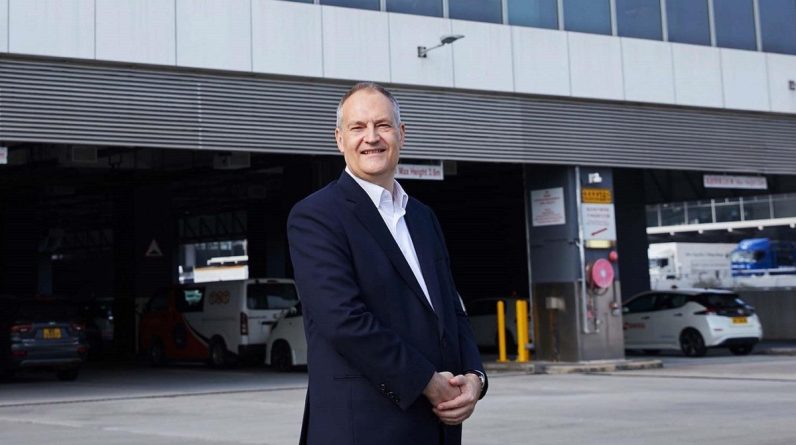
At the bustling hub of Hong Kong International Airport, the drive to digitise and decarbonise air cargo operations is not just a slogan. For Cathay Cargo Terminal, it’s a blueprint under live development. With electric autonomous tractors now moving perishables from aircraft to cool dollies and AI monitoring lithium-ion battery shipments in real time, the operator is pushing beyond industry platitudes into measurable transformation.
But as the Cathay Cargo Terminal Chief Operating Officer Mark Watts tells it, none of this progress comes without scrutiny. Speaking about the terminal’s autonomous tracker project, he emphasises “We won’t roll it out to full production at the terminal until we’re absolutely certain that it’s completely safe for our people.”
What sets Cathay Cargo Terminal’s trials apart is scope. Unlike many airport players trialling autonomous vehicles in siloed functions, Cathay Cargo Terminal focused on “genuine end-to-end” use cases. That means cargo is being moved not just from the apron to the terminal entrance, but right through to specific handover points inside the building.
“We had the first pilot run in March from inside the cargo terminal to the aircraft, and last week we completed the first operation involving perishable cargo—frozen seafood—brought autonomously into the cargo terminal using a dedicated cool dolly,” says Watts.
It’s more than just a convenience feature. “One big advantage is sustainability, because the electric tractors uses less emissions than traditional tractors,” Watts notes. So far, the team has conducted over 20 trials, including two with live cargo.
Yet he is quick to temper enthusiasm with realism. Efficiency gains are still being assessed. “It’s a pilot programme at the moment,” he says. “In terms of efficiency, we’re still working through all of the details. Safety is the priority, and will only expand usage once we are fully that appropriate risk mitigation measures are in place.
What people can’t see
Where autonomy tackles mobility, artificial intelligence is becoming Cathay Cargo Terminal’s second set of eyes. The terminal has integrated AI with its CCTV network through a technology partner called Intenseye, using real-time video analytics to flag risks invisible to human spot-checkers.
“It elevates our safety management system and hazard reporting so we can ‘see the unseen’,” Watts says. “Examples include individuals not following pedestrian walkways, or not wearing the right safety equipment or vehicles too close to each other. For certain scenarios such as detecting work from height without safety harness, we also get real-time alerts so we can immediately check that our safety protocols are being followed.”
Security is another frontier. AI-equipped cameras can now identify unattended cargo in restricted areas. Meanwhile, 100 percent of the terminal’s X-ray machines have been equipped with AI modules trained specifically to detect lithium-ion batteries. “It gives us real-time alerts if it looks like something has been misdeclared or undeclared,” Watts says.
From pledges to plastic
Cathay Cargo Terminal has committed to reaching net-zero carbon emissions by 2050, with an interim target of a 55 percent reduction by 2035 (against a 2018 baseline). But rather than scattergun commitments, Watts outlines a structured three-pillar approach: carbon, waste, and plastic circularity.
To cut emissions, the terminal is exploring autonomous electric tractors and adopting HVO (hydrotreated vegetable oil) fuel where full electrification is not yet viable. “There’s still a lot of work to do to get there,” Watts admits.
On waste, the facility is already recycling more than 50 percent of its output. A local partnership in China has made polystyrene—typically seen as unrecyclable—viable, thanks to redesigned storage and collection systems. “It’s been a very tricky material to recycle,” Watts says. “But we’ve been able to find the right way.”
The real standout is plastic circularity. The terminal recycles 100 percent of the plastic cargo cover sheets removed from incoming shipments, and uses the material to manufacture new sheets.
“We challenged our team last year to beat the industry standard,” Watts explains. “We’re still looking to see if we can increase that number over time without losing the stretchability or waterproofing needed to keep cargo safe.”
Data in, paper out
Cathay Cargo Terminal’s digitisation push isn’t just flashy AI, it also tackles the paperwork bottlenecks that define freight’s analogue past. Watts describes an operational overhaul of both outbound and inbound document flows.
The terminal was the first in Hong Kong to support electronic air waybills (e-AWB), now used in over 90 percent of shipments. But the real progress is visible in the trucker experience. “We co-developed an electronic shipment release form (eSRF) system,” says Watts, working alongside the Airport Authority Hong Kong. “Now when truckers come to pick up cargo, they no longer need to go to the Customer Centre for ID verification, paperwork, or payments. They can do everything using their mobile phone.”
The system incorporate biometric authentication and QR scanning. “The truckers are automatically directed to the right truck dock, where they can pick up their cargo and go,” he says. Within a year, the system has achieved nearly 70 percent adoption. “We also have an ambition to go entirely cashless at the cargo terminal by the end of 2026.”
Clarity over scale
Having capacity for 2.7 million tonnes annually and currently handling around 1.6 million, expansion is not the short-term priority. Instead, Watts emphasises specialisation.
“We’re focused on expanding capacity for different types of special cargo,” he says. The most prominent investment is the new Pharma Handling Centre, now the largest dedicated pharmaceutical room at Hong Kong International Airport. “We want to maintain our position as the leading handler of special cargo solutions.”
Another area of growth is intermodal integration, especially with the Greater Bay Area (GBA). Cathay Cargo Terminal supports the Hong Kong International Airport Logistics Park in Dongguan, allowing customs clearance, scanning, and acceptance procedures to occur at origin in mainland China before being barge-shipped to the HKIA tarmac for airlift. “This project can help improve overall efficiency of cargo operations from the GBA” says Watts, calling it a “big opportunity for growth.”
While the industry continues to grapple with talent shortages, Watts acknowledges the challenge of attracting younger workers to logistics, particularly for manual roles. “One of the things we’ve been focusing on very much is youth outreach,” he says. “We want to show young people that cargo and logistics is a really exciting industry.”








